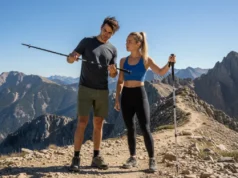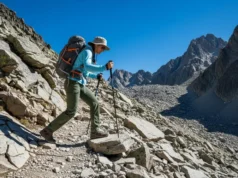In this article
Every hiker knows the feeling: the burning in your quads on a steep ascent, the jarring impact on your knees during a long descent. While trekking poles are the obvious solution, choosing the right pair is a complex puzzle of weight, durability, and cost. Many hikers either overspend on features they don’t need or buy cheap poles that fail when they’re needed most. This guide isn’t just another product list; it’s a decision-making framework designed to help you find the trekking poles that offer the best performance and lowest cost-per-mile for the way you hike.
- Learn the Expert Framework: Understand the six critical factors—from swing weight to locking mechanisms—that determine a pole’s true performance.
- Meet Your Hiker Persona: Discover if you’re a Thru-Hiker, Trail Runner, or All-Condition Backpacker to instantly narrow your search.
- Compare Top-Tier Poles: See field-tested recommendations ranked by performance, durability, and long-term value.
- Calculate True Cost: Move beyond MSRP and learn why a $200 pole can be cheaper in the long run than a $65 one.
How to Choose the Right Lightweight Poles: An Expert’s Framework
To make a smart, confident choice, you need to think like a gear analyst. This framework arms you with the objective knowledge to do just that, turning you from a passive consumer into an informed expert on your own hiker’s needs.
What’s More Important: Static Weight or “Swing Weight”?
The first number you see on the box is static weight, the simple mass of the pole, often measured in oz or g per pair. Over a 15-mile day, lifting even a few extra ounces thousands of times adds up to a significant energy cost. But that number doesn’t tell the whole story. The real secret to a pole’s feel is its “swing weight,” which is the perceived effort required to swing the pole forward with each step. It’s dictated by the pole’s moment of inertia—where the mass is distributed. A pole with heavier grips and a lighter tip feels nimble and becomes a natural extension of your arm. A tip-heavy pole, even with the same static weight, will feel cumbersome and fatiguing. A low swing weight is a game-changer for high-mileage hikers and trail runners, promoting a more natural stride and conserving precious energy. To get a true feel for this, you need to understand how to correctly size and adjust your poles first.
Pro-Tip: When testing poles in a store, don’t just hold them. Close your eyes, set them to your hiking length, and “walk” in place for 30 seconds, swinging them as you would on the trail. You’ll immediately feel the difference between a balanced pole and a tip-heavy one. The one that feels like it disappears in your hand has the better swing weight.
But no matter how light a pole feels, it’s useless if it breaks. That’s why durability, as detailed in extensive trekking pole research, is the most critical factor.
Carbon vs. Aluminum: Which Material Matches Your Risk Tolerance?
The choice between carbon fiber and aluminum isn’t about which is “better,” but which one aligns with your personal philosophy on risk versus performance. Think of aluminum 7075 alloy as the durable workhorse. Its greatest virtue is its failure mode: under extreme stress, it bends. A bent pole is often field-reparable enough to get you home safely. For hikers who prioritize absolute dependability on remote trips where gear failure is not an option, aluminum poles are the gold standard.
Carbon fiber is the lightweight champion. Its stiffness and incredible vibration-damping qualities reduce fatigue, making it the premier choice for ultralight backpackers and runners counting every gram. But its strength comes with a crucial caveat. Under the wrong kind of acute, lateral force—like getting it caught between two rocks and falling on it—it doesn’t bend. It can snap catastrophically. The choice is yours: predictable aluminum resilience or the ultimate lightweight performance of carbon. When traveling, remember to check current TSA regulations on hiking poles to ensure they are packed correctly. For a deeper dive, see our complete guide to trekking poles for backpacking.
Pro-Tip: If you choose aluminum and find yourself with a bent pole section in the backcountry, don’t try to bend it back perfectly straight over your knee. You’ll likely just create another weak point. Instead, find a smooth, flat rock and gently roll the bent section back and forth under the sole of your boot, applying steady pressure to gradually reduce the bend. It won’t be perfect, but it will be usable.
Once you’ve chosen a shaft material, the next decision is how the pole deploys and packs away.
Folding (Z-Pole) vs. Telescoping: Is Packability or Adjustability Your Priority?
Folding versus collapsible poles, often called Z-poles, are the masters of packability. They break down into short, connected sections, making them ideal for stowing in running vests or carry-on-sized luggage. Their rapid, single-motion deployment is lightning fast. The primary trade-off is often a limited or nonexistent adjustable length range.
Telescoping poles, or traditional collapsible poles, are the champions of versatility. Their sections slide into one another, offering a wide range of length adjustment. This is critical for adapting to terrain—shortening for steep ascents, lengthening for descents—and for pitching the poles for ultralight tents, a practice central to the ultralight backpacking philosophy. Their main drawback is a significantly longer collapsed length.
The mechanism that holds these sections together is a lynchpin of safety and reliability.
Grips & Locks: Why is the Human Interface So Important?
The parts of the pole you touch are what connect you to the trail. External Lever Locks, like Black Diamond’s Flick-Lock, are the undisputed industry standard for reliability. They are simple, secure, and easy to operate even with thick gloves on. Older, internal twist-lock mechanisms are more prone to slipping when dirty or failing in cold weather and are best avoided.
For grips, the choice is between Cork and EVA Foam. Cork grips are a classic for a reason: they resist moisture, dampens vibration, and slowly molds to the unique shape of your hand over time, creating a custom fit. EVA foam is lighter, softer, and absorbs sweat well, making it a favorite for ultralight purists. It’s a choice between long-term customized comfort and minimalist performance. Both materials do an excellent job of managing hand sweat, which is a key part of the crucial role of minimizing moisture to prevent blisters on your hands as well as your feet.
Finally, the straps. They are not for security. Their true purpose is power transfer. When used correctly, the strap takes the load, allowing you to maintain a relaxed, loose grip on the pole. This transfers the workload from your small, easily-fatigued hand and forearm muscles to your larger, more powerful upper arm, shoulder, and core muscles, dramatically increasing your efficiency and endurance. For a complete breakdown, see this excellent REI expert advice guide.
Now that you’re armed with this expert framework, let’s be transparent about how we applied it to find the best poles on the market.
Our Selection Process: How We Built This Guide
Our commitment is to absolute objectivity. We aren’t just listing popular poles. These recommendations are the result of a comprehensive analysis of dozens of expert field tests from professional gear labs, long-term reports from thru-hikers and ultrarunners, and data from the most respected outdoor publications.
We judged every potential product against the six critical criteria you just learned about. We evaluated Weight & Swing Feel, Durability & Reliability, Packability & Deployment, Comfort & Ergonomics, Versatility & Features, and most importantly, Long-Term Value, which we define as the “Cost-Per-Mile.”
Our selection process was two-fold. First, we identified three core hiker “personas”—The Ultralight Thru-Hiker, The Fast-and-Light Trail Runner, and The All-Condition Backpacker—to ensure our recommendations are targeted and relevant to specific needs. Second, for each persona, we curated only the highest-scoring and most field-proven poles, ensuring every choice is a justifiable, top-tier option you can invest in with confidence.
If you choose to purchase through the links on this page, we may earn a small commission at no extra cost to you. This helps support our independent research and testing. We only recommend gear we truly believe in and would carry ourselves into the mountains.
The Best Lightweight Poles of 2025: Our Top Recommendations for Every Need
Our Top Picks for The Ultralight Thru-Hiker
The Thru-Hiker operates on a razor’s edge of efficiency. Their intended use demands an optimal blend of low weight to reduce fatigue over thousands of miles, robust durability to withstand remote conditions, and precise length adjustability to serve as the critical framework for their multi-use shelter system. For them, a pole must often adjust to at least 125 centimeters for proper tent-pitching compatibility. Every gram and every feature must justify its existence.
Our Top Picks for The Fast-and-Light Trail Runner / Fastpacker
This user sacrifices everything for the lowest possible weight, the lowest swing weight, and the fastest deployment. They live and die by the clock and the gram. These are highly specialized tools, often called competition poles, that are typically ultralight, fixed-length, folding poles designed for maximum forward propulsion and minimal interference, perfect for New England fastpacking routes or the Mountain Lakes 100 race.
Our Top Picks for The All-Condition Backpacker / Day Hiker
This is the largest group of hikers, and their needs are clear: versatility, comfort, and supreme durability. For this user, absolute reliability and a low long-term cost of ownership trump the need for the lowest possible weight. These are the workhorse poles for backpacking designed to provide steadfast support on any trail, in any season, for years to come.
Conclusion
The journey to finding the right trekking pole ends where it began: with you. The best gear is a reflection of your specific mission on the trail. By understanding the core principles, you can make an informed decision that serves you for years.
Match your material to your mission by choosing durable aluminum for ultimate reliability or lightweight carbon fiber for minimizing fatigue, always understanding the critical trade-off in their failure modes. Prioritize the lock, as external lever locks offer the best combination of security, reliability, and ease of use in all conditions. Fit the pole to your purpose, recognizing that folding Z-poles are best for trail runners and travelers needing packability, while telescoping poles offer the superior adjustability needed for varied terrain and shelter-pitching.
Above all, invest in value, not just price. The best pole isn’t always the most expensive or the cheapest. It’s the one that reliably serves your needs for the most miles, offering the lowest total cost of ownership. Choosing the right outdoor gear is the first step to a safer, more enjoyable adventure. Take the framework you’ve learned today, match it to your unique hiking style, and invest in the pair of poles that will carry you confidently down the trail for years to come.
Frequently Asked Questions about Lightweight Trekking Poles
Are carbon fiber trekking poles worth the extra cost?
Yes, for many hikers, they absolutely are. If your priority is minimizing weight to reduce fatigue over long distances or on high-mileage days, the significant weight savings and superior vibration damping of carbon fiber are well worth the cost. The difference in arm fatigue at the end of a 15-mile day is noticeable. For dedicated ultralight thru-hikers and trail runners, a high-performance model like the Black Diamond Distance Carbon Z is an excellent investment in on-trail performance and endurance.
What is the most reliable type of locking mechanism?
External lever locks, often called “flick-locks” after Black Diamond’s pioneering design, are widely considered the most reliable, secure, and easy-to-use locking mechanism on the market. They are less prone to slipping under load than older twist-lock designs and can be easily operated and tensioned even while wearing thick winter gloves. Models from top brands like the Black Diamond Trail Ergo Cork and Leki Makalu Lite Cork feature best-in-class lever lock systems that are trusted by professionals for their bomber durability.
Do I need adjustable-length or fixed-length poles?
The vast majority of hikers and backpackers will benefit most from adjustable-length poles. The ability to shorten them for long uphills and lengthen them for steep downhills is crucial for maintaining optimal posture, leverage, and joint health. Furthermore, if you plan to use a trekking pole-supported tent or tarp, adjustable poles like the MSR DynaLock Ascent Carbon are often a requirement to achieve the specific height needed for a taut, storm-worthy pitch. Fixed-length poles are highly specialized tools recommended almost exclusively for competitive trail runners who prioritize the absolute lowest weight above all other features.
Are expensive trekking poles really more durable?
Generally, yes. While price isn’t the only factor, higher-priced poles from reputable brands like Black Diamond, Leki, and MSR typically use stronger, higher-grade materials, more robust and precisely engineered locking mechanisms, and superior overall construction. This translates to a longer lifespan under hard use. A pole’s true long-term value, as seen in a workhorse like the Black Diamond Trail Ergo Cork, is a combination of its initial durability and the strength of the manufacturer’s warranty and parts availability. This often makes a more expensive pole a much cheaper “cost-per-mile” investment over its lifetime.
Risk Disclaimer: Hiking, trekking, backpacking, and all related outdoor activities involve inherent risks which may result in serious injury, illness, or death. The information provided on The Hiking Tribe is for educational and informational purposes only. While we strive for accuracy, information on trails, gear, techniques, and safety is not a substitute for your own best judgment and thorough preparation. Trail conditions, weather, and other environmental factors change rapidly and may differ from what is described on this site. Always check with official sources like park services for the most current alerts and conditions. Never undertake a hike beyond your abilities and always be prepared for the unexpected. By using this website, you agree that you are solely responsible for your own safety. Any reliance you place on our content is strictly at your own risk, and you assume all liability for your actions and decisions in the outdoors. The Hiking Tribe and its authors will not be held liable for any injury, damage, or loss sustained in connection with the use of the information herein.
Affiliate Disclosure: We are a participant in the Amazon Services LLC Associates Program, an affiliate advertising program designed to provide a means for us to earn advertising fees by advertising and linking to Amazon.com. As an Amazon Associate, we earn from qualifying purchases. We also participate in other affiliate programs and may receive a commission on products purchased through our links, at no extra cost to you. Additional terms are found in the terms of service.





